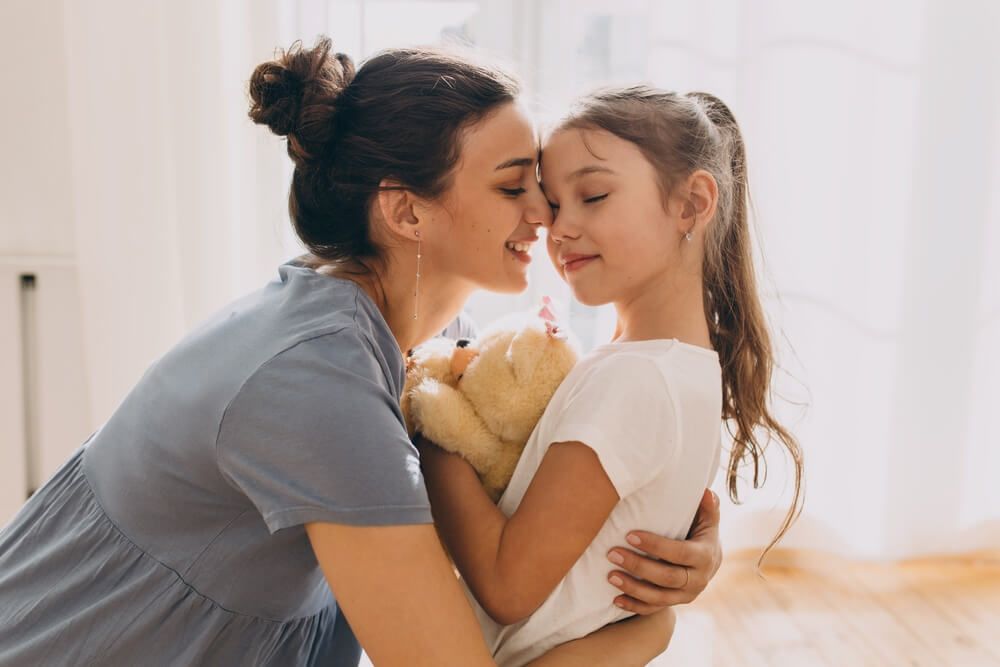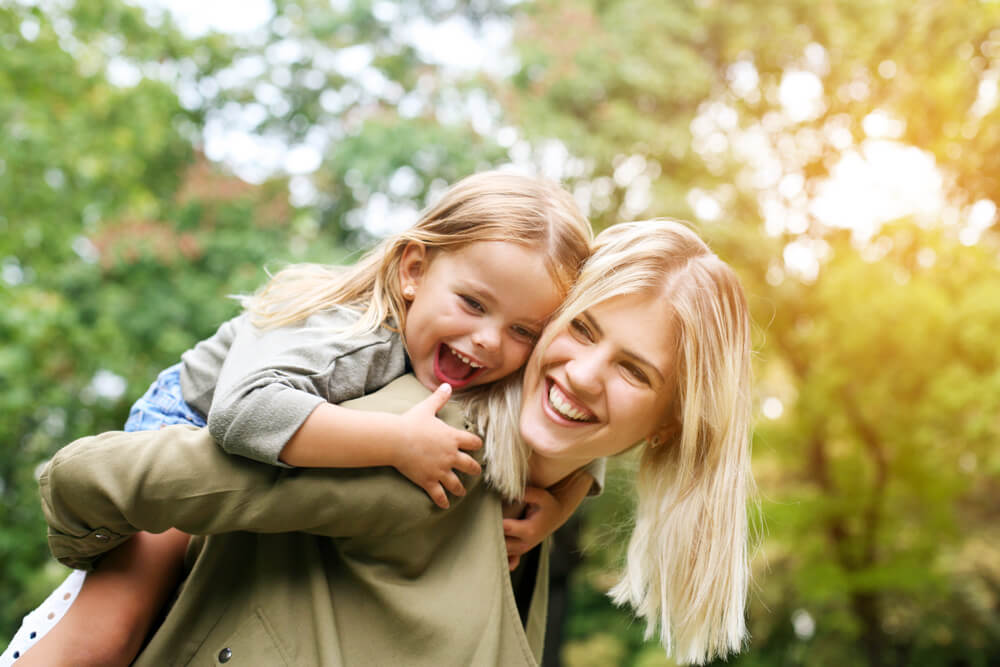Discover the Power of Mindful Parenting for Creating Harmony

Is life feeling chaotic lately? Do you strive to cultivate a calmer and more mindful approach to parenting?
If so, you’ve come to the right place! Here’s the complete guide to mindful parenting to help you and your family learn how to cultivate harmony from chaos.
Contents:
- What is Mindful Parenting?
- How Does Mindful Parenting Compare with Other Parenting Styles?
- Mindful Parenting for ADHD
- Mindful Parenting Strategies and Techniques
- FAQ
What is Mindful Parenting?

Shurkin_son/Shutterstock.com
Mindful parenting is a relatively new concept, as it’s only existed since 1997. Like mindfulness, mindful parenting is accepting where your child’s at in the moment to respond thoughtfully instead of reactively.
- Responding thoughtfully means that your parenting comes from an informed and understanding place.
- Reacting to your child’s behavior or request means you’re giving them an automatic response that likely doesn’t apply to the present moment.
The actual difference between responding thoughtfully vs. reactively lies in the acceptance of the situation and of your child. It’s not about total positivity or caving to your child’s every whim.
The key to mindful parenting is successfully managing behavior and emotion. In turn, this teaches your kids to do the same.
The beautiful thing about mindful parenting is that you get to choose. Any time you realize that you’re reacting instead of responding thoughtfully, it gives you a chance to choose to focus on the present instead of what’s happened in the past or what might happen in the future.
How is Mindful Parenting Different from Mindfulness?
Mindfulness itself occurs when a person lives in the now. For example, you practice mindfulness whenever you focus on what’s happening at the moment, today, instead of worrying about the past or future.
Someone that practices mindfulness focuses on being aware of their surroundings and how their body feels in the present moment.
Benefits of Mindful Parenting

Soloviova Liudmyla/Shutterstock.com
Experts agree that the benefits of mindful parenting help mitigate the challenges that come into a person’s life when they become a parent.
And what is one of the biggest challenges that parents face? Uncertainty.
According to INC., human beings aren’t scared of failure. The brain is afraid of the unknown, which prevents human beings from living their best lives.
Here’s more proof. In a study titled “Uncertainty and Anticipation in Anxiety,” researchers proved that participants who didn’t know whether they would receive a painful shock became much more stressed than those who knew about it before receiving one.
Don’t let the worry of the unknown get under your skin! Mindful parenting is understanding that you control only one thing: how you act in the present moment.
Focusing on the present offers some powerful benefits:
- Decreases depressive feelings and emotions.
- Improves relationships between family members.
- Lowers stress and anxiety.
- Helps parents minimize parenting efforts.
- Decreases hyperactivity symptoms.
- Promotes healthier and better communication.
- Improves self-regulation in parents and children.
- Reduces anger, outbursts, and the fight/flight response.
For further proof of the benefits of mindful parenting, here’s a study called “The Association of Parent Mindfulness with Parenting and Youth Psychopathy Across Three Developmental Stages.”
Research showed that parents who practiced mindful parenting showed a more positive parenting style, which impacted their kids who exhibited more positive behavior.
What could be better than that?
Disadvantages of Mindful Parenting

Africa Studio/Shutterstock.com
Before you can practice mindful parenting, it’s crucial to develop the skill of mindfulness first. As most parents barely have time for themselves, this can be challenging. You might notice you don’t have the energy to respond thoughtfully instead of reactively.
It’s also important to understand that not every situation requires mindful parenting. For instance, an immediate gut reaction is appropriate if your child puts themselves or others at risk.
It’s a good idea to have alternative tools in your parenting tool belt or to utilize another parenting style when an argument gets out of control. Being present doesn’t always work to solve these types of parenting situations.
Key Factors to Mindful Parenting

fizkes/Shutterstock.com
Use the following four key factors to mindful parenting to help build this helpful parenting tool.
1. Listen to Your Child’s Point of View (even if you disagree!)
Listening to your child (even when you disagree) is critical to their development. They will learn that their opinions matter and that thinking about their actions is better than reacting to what’s happened.
Children need to work out how to regulate their emotions. It’s a normal part of childhood development. As children learn, this behavior will likely leave everyone feeling frustrated.
Your child is like a sponge. How you react in any situation will teach them how to react. If a parent ignores their emotions, they will respond reactively. A child will pick up on this behavior.
The key is to tap into your feelings and pause before you respond. Once you learn both mindfulness techniques (which will take practice!), it gives you the space to listen to your child.
2. Pause Before You Respond
In most reactive situations, the response is anger or frustration due to a particular trigger. Remember, a trigger sets off the fight or flight response when in a reactive state. Neither are helpful when attempting to parent mindfully.
When something happens with your child, notice how your body reacts. In most situations, parents become short of breath or tense, which leads to a reactive response.
To prevent this from happening with your child, remember to pause before responding to them. Don’t worry if this takes some practice. It’s not easy! However, training yourself to pause and breathe before responding to your child creates a physiological change. By focusing on your breath, you decrease the urge to react and increase the function of your prefrontal cortex.
In short, you make space for calm, which enables you to feel emotion instead of reacting to the emotion. It keeps you in the moment so you can choose how to respond to your child.
3. In Conflicts: Tap into Your Feelings
Emotions can be scary. Yes, even for parents! When in conflict with your child, it’s easy for emotions to trigger your fight or flight response.
To help you tap into your feelings, try thinking about the last conflict you had with your child. What feelings come up for you? It might be any emotion: fear, shame, amusement, anger, etc.
It’s normal to try and stop yourself from feeling that emotion. If this is tricky for you, don’t worry. People don’t like to sit with uncomfortable feelings. So try thinking about them this way: you are not your emotions. Don’t push them away, judge them, or reject them. You don’t need to do anything but observe how you feel in the moment.
As you lean into mindful parenting practice, try and notice when you feel the most stressed or anxious during the day. Note these triggers and what’s happening around you, and continue to tap into your feelings and sit with your emotions.
Eventually, this process will come more naturally to you. It will also help remind you to pause before you respond to your child.
Of the three key factors, learning to tap into your feelings without blocking the emotion is crucial in understanding how to parent mindfully.
4. Make Time for Self-Care
Parents need to take time for themselves. Doing so truly helps in practicing mindfulness. Taking a break to recharge and replenish your daily resources will give you more opportunities to practice these key factors of mindful parenting.
Different types of self-care activities include:
- Going for a walk
- Calling a friend
- Talking to your partner
- Writing in a journal
- Taking a bath
- Book a personal day
Read also How to Help a Child With Body Image Issues? Body Positivity for Kids.
How Does Mindful Parenting Compare with Other Parenting Styles?

VGstockstudio/Shutterstock.com
Mindful parenting is similar and different to other parenting styles like authoritarian, permissive, authoritative, and uninvolved.
Keep reading to find out how!
Authoritarian Parenting
Parents who believe that kids need to follow their rules or parents who don’t consider their kid’s feelings often fall under the authoritarian parenting style.
This parenting style is highly rigid and is known to cause a higher risk of self-esteem problems. Why? The child’s opinions aren’t valued or heard, which can lead to anger issues later in life.
This parenting style is very different from mindful parenting as parents strive to stay mindful and listen to a child’s point of view (even if it’s wrong).
Permissive Parenting
This parenting style means parents only get involved in their child’s behavior when there’s a severe problem.
Permissive parenting is very lenient, as parents become more of a friend to their children than an authoritative adult. While permissive parents encourage children to talk to them, they often don’t discuss what might be considered bad choices or behavior.
Children with permissive parents often struggle in school and show behavioral problems as they don’t like rules.
Permissive parenting is different from mindful parenting because a parent that practices mindfulness is keen to provide feedback on behavior. The feedback is provided in a more positive and consciously chosen manner.
Authoritative Parenting
Authoritative parenting is more similar to mindful parenting because the parents who use it want to create a positive relationship with their children. Authoritative parents also explain the reason behind rules and limits while considering the child’s feelings.
Mindful parenting requires parents to take authoritative parenting one step further. Practicing mindfulness reduces the reactive interactions parents can experience with their children. Instead, parents can choose how they deal with a situation to help create a more positive relationship.
Uninvolved Parenting
Uninvolved parenting occurs when parents don’t listen or respond to their child’s needs, like shelter, clothing, and food. Little help or guidance is given to children of parents who use this parenting style, and in most situations, the child grows up on their own.
An uninvolved parenting style is very different from mindful parenting. The purpose of mindful parenting is to be present in a child’s life, which means a parent provides positive support throughout each stage of development.
Mindful Parenting for ADHD

My Good Images/Shutterstock.com
Parents of children with ADHD, anxiety, or stress disorders often try to manage behavior by overcompensating to manage triggers. The challenge is that it leads parents to focus on how their child should behave instead of how their child behaves.
Parents that use mindful parenting better to understand the world through their child’s eyes help to create moments of calm and joy instead of frustration.
and here’s the proof: a study published in the National Library of Medicine (NIH) shows that practicing mindful parenting on male students “reduces the symptoms of hyperactivity/impulsivity and inattention behaviors of children with ADHD in the experimental group compared to the control group.”
The study concluded, “The findings generally show that mindful parenting education has affected the emotional climate governing parent-child interactions and has reduced behavioral problems in children suffering from ADHD.”
Mindful Parenting Strategies and Techniques

Liderina/Shutterstock.com
Here are a few tips, strategies, and techniques to help make mindful parenting part of your daily routine.
Meditate
Mindful parenting is based on meditation techniques. Like mindful parenting, meditation is a great skill to learn because it helps focus the mind on a subject or activity in a calm and aware state.
Practice Active Listening
Active listening is listening to understand instead of replying or responding. Most people listen but then stop as they begin to think about how they will respond.
Practicing active listening is helpful for mindful parenting because it keeps you in the present and ensures you understand your child and their needs.
Use Child Safety Apps
Child safety apps give parents peace of mind.
Available for iPhone and Android, apps like Findmykids help keep families safe and secure. Parents can receive notifications about family members’ locations, restrict websites and apps, and even receive an SOS signal.
With Findmykids, being a mindful parent is possible because there’s no need to stress or worry. You can stay in the moment and know your kids are thriving.
For more strategies and techniques (and a great definition of mindful parenting), check out this short video from the Greater Good Science Center:
FAQ
Curious to know more about mindful parenting? Keep reading to get the answers to some of the most frequently asked questions.
What is an Example of Mindful Parenting?
How can you be a mindful parent when your toddler loses it emotionally and throws tantrums in a store?
Public tantrums can trigger you as a parent. You might feel judged by everyone watching or shame at your child’s behavior.
Accept how you feel in the moment. Also, accept that your child had a long day, is getting hungry, or just wants your attention. Your child is dealing with some big emotions of their own. They aren’t trying to embarrass you in front of strangers.
So you don’t need to buy them candy, but you also don’t need to rush out of the store angrily. Pause, breathe, and listen to understand the cause of their actions (while maintaining your boundaries).
What are the Five Dimensions of Mindful Parenting?
according to the model of mindful parenting, the five dimensions of mindful parenting include:
- Listening with full attention
- Non-judgemental acceptance of the self and the child
- Emotional awareness of the self and the child
- Self-regulation in the parenting relationship
- Compassion for the self as the parent and the child
What are the Goals of Mindful Parenting?
The American Psychological Association states that when it comes to mindful parenting, there are three main goals. These goals are to:
- Ensure the health and safety of children.
- Prepare children for life as (productive) adults.
- Transmit cultural values.
How Do You Teach Mindful Parenting?
It’s possible to teach mindful parenting by modeling the behavior with children. The key steps to remember in mindful parenting include the following:
- Stop—Don’t react. Wait a moment.
- Breathe—Relax your muscles.
- Observe—Be curious about the situation.
- Continue—Respond to the child.
In this way, children learn how to regulate their emotions, a crucial skill they’ll need as adults.
Mindful Parenting in 2023
While challenging, the best part about mindful parenting is that it helps parents and caregivers feel less overwhelmed and stressed.
Mindful parenting cultivates harmony from chaos. By learning to pause, step back, and live in the present (when possible), kids feel calmer and learn how to regulate their emotions.
Join the conversation! Do you want to try mindful parenting? Has a mindful parenting approach helped your family? Or do you have any mindful parenting tips? Leave a comment to let us know your thoughts on mindful parenting.
The picture on the front page: Evgeny Atamanenko/Shutterstock.com
Проверьте электронный ящик



















